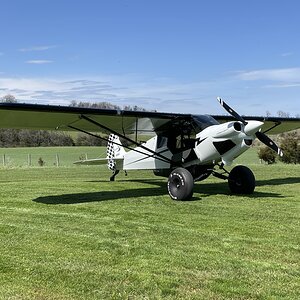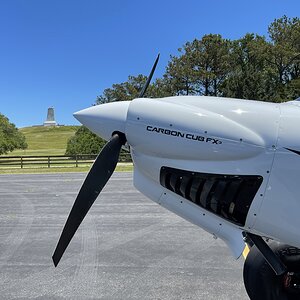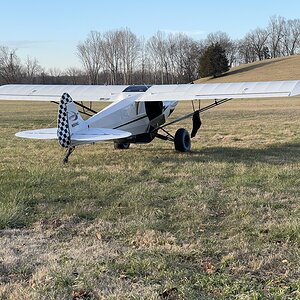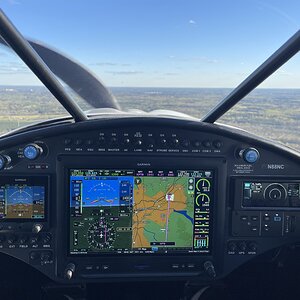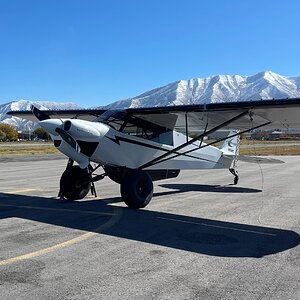Navigation
Install the app
How to install the app on iOS
Follow along with the video below to see how to install our site as a web app on your home screen.
Note: This feature may not be available in some browsers.
More options
Welcome to Flightinfo.com
- Register now and join the discussion
- Friendliest aviation Ccmmunity on the web
- Modern site for PC's, Phones, Tablets - no 3rd party apps required
- Ask questions, help others, promote aviation
- Share the passion for aviation
- Invite everyone to Flightinfo.com and let's have fun
You are using an out of date browser. It may not display this or other websites correctly.
You should upgrade or use an alternative browser.
You should upgrade or use an alternative browser.
any one flies falcon 2000EX
- Thread starter pilot1704
- Start date
- Watchers 10
2000flyer
EASY FLYER
- Joined
- Nov 26, 2001
- Posts
- 1,586
pilot1704 said:Hi!
My company is getting Falcon 2000EX, any one here flying it!
What is your toughts!
Yes and FANTASTIC! We've got an EASy. Still experiencing some growing pains with the electronics and typical "new" airplane items, but nothing that hasn't been easily fixed. We've put about 50 hours on it so far and are thoroughly pleased. Climbs like a banshee. Typical acceleration in our old 2000 was .34-.36. I've seen .48 on the new plane so far and mid-weights. No lag in the mid-30s that the older 2000 suffered from. You're gonna love it!
Feel free to PM me with any questions you might have.
Regards,
2000Flyer
2000flyer
EASY FLYER
- Joined
- Nov 26, 2001
- Posts
- 1,586
Heavy Set said:What do you like best about the new cockpit (EASy)? How is it better than the previous package in your opinion? How do you use it differently?
EASy is completely different from any other EFIS package I've ever operated. Much is getting used to CCD's (track balls) and a menu driven set of screens. The only displays you can't change to something else, for obvious reasons, are the primary flight instruments (attitude, heading, etc.). If you have any experience operating a PC, you'll quickly become acclimated to the system.
From an operational standpoint, it's a great system. Loads of information available and a very intuitive system. Systems graphics are great, all displays are clear and chock full of information.
On the Dassault side of the system, getting used to flying path rather than pitch took a little getting used to. However, once you've done it, you (or at least I) wonder why it hasn't been this way longer.
The FMS no longer has a dedicated CDU (screen) for each. All flight plans and performance are built from screens for each phase of flight and displayed on both a "Flight Management" screens, and the upper "INAV" screen. If your used to the paper flight plan you get from AFIS or Jepp, imagine that on the INAV screen.
By far, Honeywell has done a great job with their EPIC system. Dassault tweaked it to their liking, sans EASy. Gulfstream did the same, sans Planeview. EPIC is on the Citation Sovereign, though from what little I've seen on the plane, they generate a more "traditional" display, though it is also a menu driven display with CCDs. From what I've read, Gulfstream went with a joystick on the left and right side of the cockpit, rather than a pedestal mounted CCD.
Regards,
2000Flyer
GVFlyer
Well-known member
- Joined
- Feb 22, 2002
- Posts
- 1,461
The four 14.1 inch Planeview Displays on the G350/G45O/G500/G550 can be controlled either by the Eyebrow Panel mounted Display Controllers or by the side-arm mounted Cursor Control Devices (CCD). The CCD's developed over a two year period by Gulfstream engineer, Susan Taylor, are the objects looking like armrests in the G550 360 Degree Virtual Cockpit Tour which can be selected from the link below. On top is a thumb operated Chinese Hat to drive the cursor and below a finger located button to select items as well as a second press to talk switch. The CCD is grasped like a control stick. A joystick as well as touchpads, trackballs and other means of controlling the cursor were evaluated and discarded as unusable in turbulence.2000flyer said:From what I've read, Gulfstream went with a joystick on the left and right side of the cockpit, rather than a pedestal mounted CCD.
Regards,
2000Flyer
http://www.gulfstream.com/product_enhancement/planeview/#
GV
.
Last edited:
AA717driver
A simpler time...
- Joined
- Mar 27, 2003
- Posts
- 4,908
GVFlyer
Well-known member
- Joined
- Feb 22, 2002
- Posts
- 1,461
AA717driver said:GVflyer or GEXDriver--If you make occasional trips over the pond but don't need the 400 lb. Gorrilla like a 550 or GEX, do you have sufficient redundancy in the GIV that the 2000EX lacks? Thanks.TC
Glad you asked! The short answer is yes.
Class C (Aeroplanes)
Sub-class C-1 (Landplanes)
Group 3 : turbo-jet
Speed around the world, Westbound : 810.98 km/h
Date of flight: 14/06/1987
Pilot: Allen E. PAULSON (USA)
Crew: K. C. EDGECOMB, Jefferson BAILEY, John SALAMANKAS, Colin B. ALLEN
Course/place: Paris (France) and return (via Edmonton, Nome, Midway, Manila, Kota Kinabalu, Madras, Dubai, Bahrein, Dahran, Cairo)
Aircraft: Gulfstream G-IV (2 RR Tay MK-618-8, 13 850 lb each)
Registered 'N440GA'
Al and the boys beat the Boeing 747 around the world record with this trip.
The G-IV/ G400 has three 30 KVA power sources, any one of which will normally carry 100% of the aircraft electrical load and a 7 KVA ABEX hydraulic motor generator that will power the essential bus.
On the G450, the G400 Electrical Power System is replaced with the more capable system proven on the GV/G550. Two 40kVA Integrated Drive Generators and a 40 kVA APU Generator provide a significant improvement in electrical power capacity, no-break power transfer capability, and added redundancy for safe, reliable operation.
A new version of the Honeywell 36-150 APU provides improved reliability for engine starting, better performance for cabin temperature control, and improved high altitude electrical power capacity. The 36-150 is also ramp-friendly, with exterior noise levels greatly reduced from that of the G400.
GV
AA717driver
A simpler time...
- Joined
- Mar 27, 2003
- Posts
- 4,908
GVFlyer said:A new version of the Honeywell 36-150 APU provides improved reliability for engine starting, better performance for cabin temperature control, and improved high altitude electrical power capacity. The 36-150 is also ramp-friendly, with exterior noise levels greatly reduced from that of the G400.
GV
Yeah, but will it still roast you as you walk out from under the right wing after inspecting the R Main landing gear?
Thanks for the info, GV! TC(Getting ready to do my second LAX-CPH in 6 mos.
G100driver
Well-known member
- Joined
- Jun 18, 2002
- Posts
- 2,094
Yawn.AA717driver said:GVflyer or GEXDriver--If you make occasional trips over the pond but don't need the 400 lb. Gorrilla like a 550 or GEX, do you have sufficient redundancy in the GIV that the 2000EX lacks? Thanks.TC
Lead Sled
Sitt'n on the throne...
- Joined
- Apr 1, 2004
- Posts
- 2,066
But does it have three engines?GVFlyer said:Glad you asked! The short answer is yes.
Class C (Aeroplanes)
Sub-class C-1 (Landplanes)
Group 3 : turbo-jet
Speed around the world, Westbound : 810.98 km/h
Date of flight: 14/06/1987
Pilot: Allen E. PAULSON (USA)
Crew: K. C. EDGECOMB, Jefferson BAILEY, John SALAMANKAS, Colin B. ALLEN
Course/place: Paris (France) and return (via Edmonton, Nome, Midway, Manila, Kota Kinabalu, Madras, Dubai, Bahrein, Dahran, Cairo)
Aircraft: Gulfstream G-IV (2 RR Tay MK-618-8, 13 850 lb each)
Registered 'N440GA'
Al and the boys beat the Boeing 747 around the world record with this trip.
The G-IV/ G400 has three 30 KVA power sources, any one of which will normally carry 100% of the aircraft electrical load and a 7 KVA ABEX hydraulic motor generator that will power the essential bus.
On the G450, the G400 Electrical Power System is replaced with the more capable system proven on the GV/G550. Two 40kVA Integrated Drive Generators and a 40 kVA APU Generator provide a significant improvement in electrical power capacity, no-break power transfer capability, and added redundancy for safe, reliable operation.
A new version of the Honeywell 36-150 APU provides improved reliability for engine starting, better performance for cabin temperature control, and improved high altitude electrical power capacity. The 36-150 is also ramp-friendly, with exterior noise levels greatly reduced from that of the G400.
GV
GVFlyer
Well-known member
- Joined
- Feb 22, 2002
- Posts
- 1,461
Anytime. LA to Kobenhavn is just a chip shot - you should be able to do that in under 10 hours. Great destination, too!AA717driver said:Thanks for the info, GV! TC(Getting ready to do my second LAX-CPH in 6 mos.)
GV
GVFlyer
Well-known member
- Joined
- Feb 22, 2002
- Posts
- 1,461
No, nor does it need them.Lead Sled said:But does it have three engines?
It is difficult to come by recent statistical information on the failure rate of TFE-731's as Dassault has clamped down on Allied Signal and they no longer release this information. But prior to this blackout, their statistics showed that you were more likely to arrive single engine in the Allied Signal powered three-holer Falcon than you were in the twin engined Rolls Royce powered Gulfstream.
If three-engined airplanes were a good idea then someone in addition to Dassault would make them.
The G450 is not ETOPS certified (ETOPS applies only to Part 121 aircraft), but the jet meets double the ETOPS 180 requirements, which is a testament to it's reliability.
By the way, are you suggesting that the Boeing 777 should have been made with three engines like failed designs such as the MD-11, the DC-10 and the L1011?
GV
banned username 2
Banned User
- Joined
- Nov 25, 2001
- Posts
- 3,254
You forgot about that other huge failure of a 3 engine airplane design...GVFlyer said:By the way, are you suggesting that the Boeing 777 should have been made with three engines like failed designs such as the MD-11, the DC-10 and the L1011?
The B-727
BTW, the reason the 757, 767 and 777 are all twins is because the airlines dictated that they wanted twins to reduce maintenance costs, not because 2 engines is a particularly good idea... Airlines are the buyers so they make (most of) the rules when it comes to those things...
Lead Sled
Sitt'n on the throne...
- Joined
- Apr 1, 2004
- Posts
- 2,066
No, it should have been built with 4.GVFlyer said:By the way, are you suggesting that the Boeing 777 should have been made with three engines like failed designs such as the MD-11, the DC-10 and the L1011?
Lead Sled
Sitt'n on the throne...
- Joined
- Apr 1, 2004
- Posts
- 2,066
I agree with Falcon Captain...Falcon Capt said:...the reason the 757, 767 and 777 are all twins is because the airlines dictated that they wanted twins to reduce maintenance costs, not because 2 engines is a particularly good idea... Airlines are the buyers so they make (most of) the rules when it comes to those things...
I believe that the main driving force behind ETOPS is the need to cut airline operating costs and one of the major ways this is done is by eliminating engines. In years past, engines were a pilot's security blanket - the more the merrier. The earlier generation engines didn't have the power, the reliability, nor the efficiency of today's powerplants - hence, in order for an early generation jet aircraft to be large enough to be economically viable it had to have several (4, 6, or 8) engines. (B-707, B-47, B-52) The side benefit was that in the event of an engine failure you only lost 1/4, 1/6, or 1/8th of the available thrust.
Today's engines are more reliable, more powerful, and more economical. They have the power and the reliability to enable twin-jets to safely operate over oceanic routes. Or at least that's what the airline's accountants want us to believe. If you ask almost any experienced pilot would he rather fly a 3 or 4 engine verses a twin-jet on those long oceanic legs I think that, to a person, you would find that they would favor 3 or 4 engine aircraft for those trips. This isn't to say that ETOPS operations aren't safe, but rather I believe that most pilots simply would prefer more than two engines on those routes.
I've got a friend who is a 747 captain. He put it best when he said that when a 3 or 4 engine jet looses an engine it's an inconvenience - not an emergency. Engine failures on these aircraft aren't even included on the Emergency checklist, it's considered an abnormal procedure. On a twin-jet, it's definitely something that's easily handled but, never the less, it's still an emergency.
Oh well, enough of this let's discuss something that really matters. You choose.
'Sled
FracCapt
Clown punchers, unite!
- Joined
- Mar 11, 2004
- Posts
- 1,415
Lead Sled said:If you ask almost any experienced pilot would he rather fly a 3 or 4 engine verses a twin-jet on those long oceanic legs I think that, to a person, you would find that they would favor 3 or 4 engine aircraft for those trips.
To put things in perspective....tell me....how many 2 engine airplanes have been lost at sea due to double engine failure? Hmmm?
Ummm....PFT?Oh well, enough of this let's discuss something that really matters. You choose.
SPBRIAN
Well-known member
- Joined
- Nov 19, 2002
- Posts
- 103
I'm becoming a big fan of any kind of a dark, must be the season here in the northwest. Better yet, what's the best kind of beer to go with BBQ? Even better than that anybody know of some really great BBQ in Oregon?FracCapt said:Ummm....PFT?No no no....seriously....beer....favorite flavor? Tough call here...but I'd have to go with either Harp or Guiness Stout..
-SPB
FracCapt
Clown punchers, unite!
- Joined
- Mar 11, 2004
- Posts
- 1,415
I love Shiner....and it's finally becoming widely available. 5 years ago I had to go to Texas anytime I wanted some!bigD said:For a good midlevel beer - Shiner Bock. Goes well with BBQ too!
Latest resources
-
-
-
-
-
AC 90-89C - Amateur-Built Aircraft and Ultralight Flight Testing HandbookAmateur-Built Aircraft and Ultralight Flight Testing Handbook
- Neal
- Updated:

